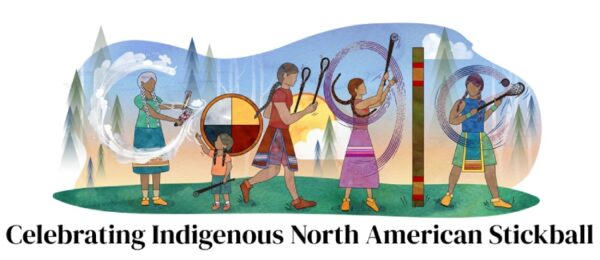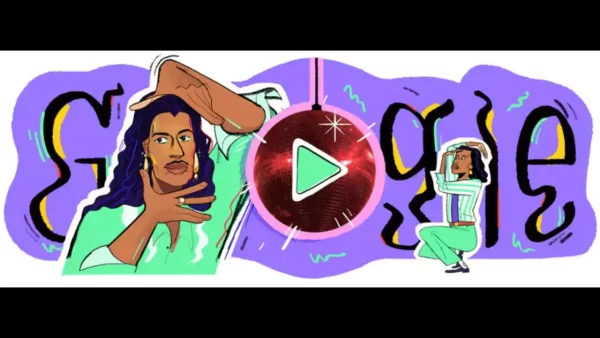
Fascinating Insights into Indigenous North American Stickball: Uncovering its Rich History and Cultural Significance
Google Doodle Honors Indigenous North American Stickball for US Native American Heritage Month
In commemoration of US Native American Heritage Month, Google showcased a captivating Google Doodle on November 1, 2022, celebrating the ceremonial sport of Indigenous North American stickball. This traditional game has its origins in Native American tribes and holds significant cultural importance.
Interesting and Fun Facts about Indigenous North American Stickbal
Indigenous North American stickball is recognized as one of the oldest team sports in the region, dating back centuries. Tribes such as the Cherokee, Chickasaw, Choctaw, Seminole, and Yuchi were among those known to engage in stickball. Tribal elders often organized stickball games as a means of resolving disputes without resorting to violence, highlighting the sport’s peaceful nature.
Although stickball and lacrosse share similarities, lacrosse is predominantly associated with tribes from the Northern United States and Canada, while stickball continues to thrive in Oklahoma and parts of the Southeastern US, where the game originated.
Traditional stickball games were grand events that could span several days, attracting participants and spectators alike. The game’s origins are shrouded in the mists of time, with the earliest recorded mention dating back to the 1600s.
An intriguing Cherokee story recounts the inaugural stickball match between land animals and birds. The land animals, including a bear, deer, and turtle, relied on sheer strength, assuming victory was assured. Conversely, the avian team utilized flight, speed, and cunning to outmaneuver their opponents. Ultimately, the birds emerged triumphant.
Historically, the “stick” in stickball was fashioned from a tree branch or sapling, skillfully twisted and bound with leather to create a netted opening capable of accommodating the ball. The ball itself was often crafted from cloth and wrapped with leather strips.
Also Read: Commemorating US National Memorial Day 2023: Google Doodle Honors with a Solemn Grey Tribute
As a team sport, stickball aims to maneuver the ball towards the rival team’s goal line, with the initial rule prohibiting the use of hands to touch the ball. Over time, additional rules were implemented to protect players, as intense stickball games occasionally led to violence.
The game of stickball played a pivotal role in various historical events. For instance, in 1763, the Ottawa tribe employed a stickball match as a strategy to gain access to Fort Mackinac. Chief Pontiac of the Ottawas invited warriors from the fort to witness the game as part of the king’s birthday tribute. While the warriors were engrossed in the festivities, the Ottawa players stealthily approached the fort and attacked the unsuspecting defenders.
In 1834, after the Caughnawaga Indians showcased stickball in Montreal, Canada, the game captivated numerous Canadians. Eventually, William George Beers codified the indigenous game into modern lacrosse in 1856.
These ancestral Native American games continue to be played by numerous tribes across North America, experiencing a “renaissance” primarily in the southern region since the mid-to-late twentieth century. Stickball not only serves as a recreational sport but also fosters connections between tribes.
Stickball requires sticks of varying lengths, each featuring a net on one end. Two teams endeavor to pass and move the ball towards their opponent’s goalpost, with points earned by touching or hitting the post. The fundamental rule remains steadfast: the ball cannot be touched with hands. Different tribes maintain their unique variations of stickball, preserving the game’s ceremonial traditions, which remain a staple of Native American culture.
Interestingly, modern-day field lacrosse traces its roots back to stickball, underscoring the enduring legacy and influence of this ancestral game.
Google’s decision to feature Indigenous North American Stickball in a Google Doodle on November 1, 2022, serves as a tribute to the sport’s significance. The artwork, created by Marlena Myles, beautifully represents the essence of stickball and highlights its cultural value. By showcasing this traditional game, Google aims to raise awareness of Native American heritage and the importance of preserving cultural traditions during US Native American Heritage Month.
Google Doodle for Celebrating Indigenous North American Stickball
In celebration of US Native American Heritage Month, today’s Google Doodle observes Indigenous North American stickball.
The Google Doodle artwork was delineated by Saint Paul-based artist, Marlena Myles who is a member of the Spirit Lake Dakota/Mohegan/Muscogee tribe.
The present Google Doodle artwork focuses on telling the story of Stickball, mixing customs around the game and the modern way it is played. The style is inspired by traditional ledger art (account drawing or painting on paper or cloth) and purposefully incorporates women and men of different ages to depict the inclusivity of the sport.
Also Read: Exploring Fascinating Fact about Abdul Rahman Munif, the Saudi Arabian Novelist
The art likewise portrays the gameplay of three different versions of stickball, including the ceremonial pregame practice of sage smudging (an old Native American practice of burning dried plants) as found in the “G” letter formation.
Starting around 1990, in the US, the month of November has been dedicated to Native American Heritage Month. The event is intended to be a chance to reflect on the contributions and history of the land’s first people, and Google has decided to feature the traditional game of Indigenous North American stickball.
To best honor this historic game, Google tapped artist and member from the Spirit Lake Dakota/Mohegan/Muscogee tribe, Marlena Myles. The present Google Doodle portrays the numerous roles and types of players including Indigenous North American stickball.
For example, the initial letter G is represented by a sage or tobacco smudging ceremony, done to cleanse the players’ spirits. In the interim, different kinds of sticks are shown, including one player holding two netted sticks.
Google Doodle Celebrates Indigenous North American Stickball
In recognition of US Native American Heritage Month, today’s Google Doodle pays homage to the rich tradition of Indigenous North American stickball.
The artwork for the Google Doodle was beautifully crafted by Marlena Myles, an artist based in Saint Paul and a proud member of the Spirit Lake Dakota/Mohegan/Muscogee tribe.
The artwork captures the essence of stickball by blending traditional customs with its modern interpretation. Inspired by the art form of ledger art, which involves drawing or painting on paper or cloth, the illustration intentionally includes women and men of different ages, symbolizing the inclusive nature of the sport.
Also Read: Exploring the Life of Barbara May Cameron: Native American Writer and Human Rights Activist
The artwork also depicts three variations of stickball gameplay, including the ceremonial pregame practice of sage smudging—a time-honored Native American tradition of burning dried plants. This can be seen in the formation of the letter “G” within the artwork.
Since around 1990, November has been designated as Native American Heritage Month in the United States—a time to reflect on the contributions and history of the country’s indigenous people. In alignment with this celebration, Google has chosen to highlight the traditional game of Indigenous North American stickball.
To ensure the utmost respect for this historic game, Google collaborated with Marlena Myles, an artist and member of the Spirit Lake Dakota/Mohegan/Muscogee tribe. The resulting Google Doodle showcases the diverse roles and players associated with Indigenous North American stickball.
For instance, the initial letter “G” represents a ceremonial sage or tobacco smudging ceremony, performed to purify the spirits of the players. Additionally, the artwork portrays various types of sticks used in the game, with one player depicted holding two netted sticks, showcasing the unique dynamics of stickball.



